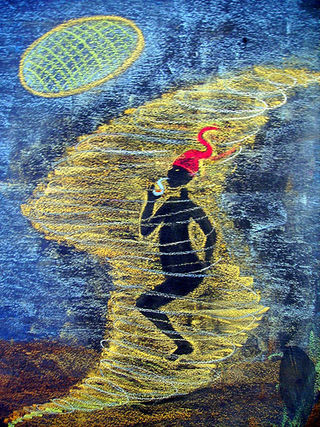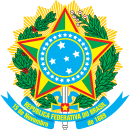The Tupi-Guarani mythology is the set of narratives about the gods and spirits of the different Tupi-Guarani peoples, ancient and current. Together with the cosmogonies, anthropogonies and rituals, they form part of the religion of these peoples.

The bogeyman is a mythical creature used by adults to frighten children into good behaviour. Bogeymen have no specific appearances and conceptions vary drastically by household and culture, but they are most commonly depicted as masculine or androgynous monsters that punish children for misbehaviour. The bogeyman, and conceptually similar monsters can be found in many cultures around the world. Bogeymen may target a specific act or general misbehaviour, depending on the purpose of invoking the figure, often on the basis of a warning from an authority figure to a child. The term is sometimes used as a non-specific personification of, or metonym for, terror, and sometimes the Devil.

Deer have significant roles in the mythology of various peoples located all over the world, such as object of worship, the incarnation of deities, the object of heroic quests and deeds, or as magical disguise or enchantment/curse for princesses and princes in many folk and fairy tales.

Saci is a character in Brazilian folklore. He is a one-legged black man, who smokes a pipe and wears a magical red cap that enables him to disappear and reappear wherever he wishes. Considered an annoying prankster in most parts of Brazil, and a potentially dangerous and malicious creature in others, he nevertheless grants wishes to anyone who manages to trap him or steal his magic cap. However, his cap is often depicted as having a bad smell. Most people who claimed to have stolen this cap say they can never wash the smell away. In addition to having only one leg, Saci has a hole in both palms of his hands. A favorite pastime of Saci, is passing a lit match through these holes. The legend says that a person can trap a Saci inside a bottle when he is in the form of a dust devil.

Parintins Folklore Festival, or often also called Festival do Boi-Bumbá, Bumba Meu Boi, or simply Festival, is a popular annual celebration during three days in late June held in the Brazilian city of Parintins, Amazonas. It is one of the largest annual festivals in Brazil; only the Carnival festivities in Rio de Janeiro and Salvador draw more participants. The festival is recognized as a Cultural Heritage of Brazil by the National Institute of Historic and Artistic Heritage.
Estonian mythology is a complex of myths belonging to the Estonian folk heritage and literary mythology. Information about the pre-Christian and medieval Estonian mythology is scattered in historical chronicles, travellers' accounts and in ecclesiastical registers. Systematic recordings of Estonian folklore started in the 19th century. Pre-Christian Estonian deities may have included a god known as Jumal or Taevataat in Estonian, corresponding to Jumala in Finnish, and Jumo in Mari.

Bumba Meu Boi is an interactive play celebrated in Brazil. It originated in the 18th century. It is a form of social criticism. Lower class Brazilians mock and criticize those of higher social status through a comedic Folklore story told in song and dance. Though not as well known internationally as Carnival and other Brazilian festivals, it is older and deeply rooted in the culture of Brazil. The tale can vary depending on the region and social setting at which it is practiced. However, its essential theme remains the same, with a focus on the death and resurrection of an ox.
The Curupira is a mythological creature present in the Tupi-Guarani myths in the Amazon rainforest of Brazil.
The Enchanted moura or moura encantada is a supernatural being from the fairy tales of Portuguese and Galician folklore. Very beautiful and seductive, she lives under an imposed occult spell. Shapeshifters, the mouras encantadas occupy liminal spaces and are builders with stone of formidable strength.

Iara, also spelled Uiara, Yara or Hiara or Mãe das Águas, is a figure from Brazilian mythology based on the ancient Tupi and Guaraní mythology. The word derives from Old Tupi yîara = y ("water") + îara = "lady of the lake". Depending on the oral tradition and the context of the story, she can be seen either as a water nymph, a siren, or a beautiful mermaid that lives in the Amazon River.

Colombian folklore are beliefs, customs and cultural traditions in Colombia.

West African mythology is the body of myths of the people of West Africa. It consists of tales of various deities, beings, legendary creatures, heroes and folktales from various ethnic groups. Some of these myths traveled across the Atlantic during the period of the Trans-Atlantic slave trade to become part of Caribbean, African-American and Brazilian mythology.
Anhangá or Anhanga, is a figure present in the cosmovision of several native groups from Brazil and indianist literature.








